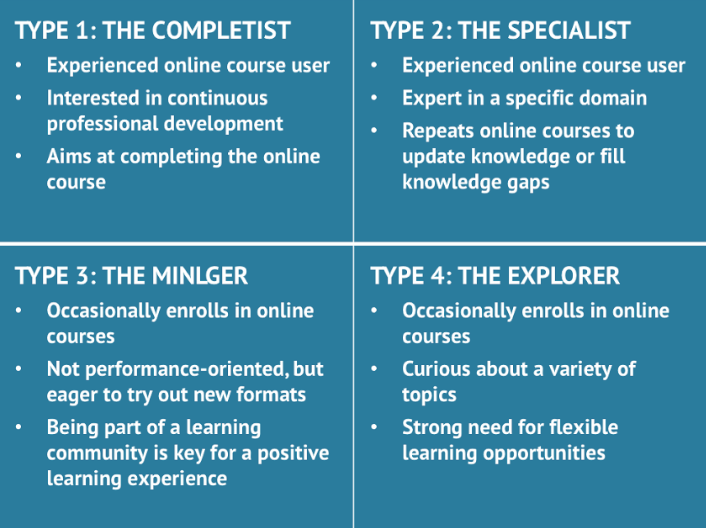Unsere vernetzte Welt verstehen

Klick-Banden: Nutzertypologie in Online-Kursen
Es sollte die große pädagogische Wende bringen: Die besten Universitäten der Welt boten Onlinekurse an, kostenlos für alle mit Internetanschluss. Die Begeisterung war hoch, ebenso wie die Einschreibungszahlen – doch überraschend wenige TeilnehmerInnen schlossen ihre Kurse ab. Unsere assoziierte Forscherin Anna Hansch versuchte zu verstehen, warum. In ihrer Dissertation untersuchte sie, wie die NutzerInnen auf einige der neuen Ansätze reagieren, die Online-Lernplattformen nutzen um Engagement zu wecken, wie z.B. „Gamifizierung“. Das Ergebnis ihrer empirischen Analyse ist die Entwicklung einer Nutzertypologie und mehrerer Empfehlungen für die Gestaltung von Onlinekursen, die wirklich sinnvolles Engagement fördern.
Massive Open Online Courses (MOOCs) kickstarted new possibilities for online learning. World-renowned institutions of higher learning can now offer free courses to anyone via the Internet. Education is transforming from a few years of strictly organized, on campus studying into lifelong learning that fits participants’ schedules and geographical constraints. To date, 81 million learners have signed up for 9,400 courses on a variety of topics, from machine learning to graphic design.
Universities aren’t the only ones taking advantage of online learning platforms. Businesses have also started using online courses to train employees. In the ongoing shift from an industrial to an information economy, many workers must keep pace with technological developments affecting their positions, like the expanding role of robotics and artificial intelligence. Online courses can specifically cater to a company’s training needs, keeping their employees a step ahead of the technology, and their business a step ahead of the competition.
Pass or Fail?
Despite the promise of free online courses, they’ve been criticized by both educators and researchers for their low user engagement and low completion rates, which range between 5% and 16%. Since user engagement is an invaluable component of the learning process, the potential for success of this new educational format is starting to be reconsidered.
One possible reason for the shortcomings of online courses is their focus on technology over pedagogy. Developed by entrepreneurial non-educators with little research into the success factors of previous online learning attempts, early MOOCs were especially tech-centered and tested more for their marketability than educational success.
Get your head in the game
As online learning providers continue to search for new ways to improve user experience, they’ve begun experimenting with novel approaches like gamification. These playful additions have real potential to increase engagement. However, gamification tends to be implemented in a one-size-fits-all fashion, without taking actual user interaction into account. Until now, there’s been a dearth of research into how to taylor gamification to users’ specific learning needs and truly encourage meaningful participation.
So what types of users are on gamified online learning platforms? And how can courses be designed around users’ specific learning needs? These are the questions that sparked the research in my dissertation “New Interactions in Online Courses: Developing a User Typology.”
Click cliques: the four types of online course users
Four unique user types in online courses were derived from my qualitative, multi-level study: the Completist (type 1), the Specialist (type 2), the Mingler (type 3), and the Explorer (type 4). Each user type differs in terms of learning strategy, course goal, prefered social learning situation, approach to course material, and response to gamification elements.
The four user types can be further grouped into two camps: content-driven learners, and media-driven learners. The self-motivated content-driven learners (types 1 and 2) actively pick and choose content when and how they want, regardless of the format. The more passive media-driven learners (types 3 and 4) expect course content to be presented with all the bells and whistles of modern media, creating an engaging learning adventure.
Here’s your homework: Designing for the user types
The conclusions of my dissertation indicate that the high drop-out rates in online courses are a symptom of their lack of user-centered design. Paradoxically, even though online learning platforms are entirely Internet-based, the courses fail to take into account how users actually interact with digital media in their everyday life.
To address these shortcomings, the proposed typology recommends building online courses around the needs of the users. By putting the four user types at the center of course development, online learning platforms can better foster successful lifelong learning and help transform education for the 21st century.
Learn more about the user types and how to design engaging learning experiences around them in the book “Neue Interaktionen in Online-Kursen: Entwicklung einer Nutzertypologie“. Available on epubli.com and other online booksellers.
Dieser Beitrag spiegelt die Meinung der Autor*innen und weder notwendigerweise noch ausschließlich die Meinung des Institutes wider. Für mehr Informationen zu den Inhalten dieser Beiträge und den assoziierten Forschungsprojekten kontaktieren Sie bitte info@hiig.de

Jetzt anmelden und die neuesten Blogartikel einmal im Monat per Newsletter erhalten.
Digitale Zukunft der Arbeitswelt
Der Human in the Loop bei der automatisierten Kreditvergabe – Menschliche Expertise für größere Fairness
Wie fair sind automatisierte Kreditentscheidungen? Wann ist menschliche Expertise unverzichtbar?
Gründen mit Wirkung: Für digitale Unternehmer*innen, die Gesellschaft positiv gestalten wollen
Impact Entrepreneurship braucht mehr als Technologie. Wie entwickeln wir digitale Lösungen mit Wirkung?
Bias erkennen, Verantwortung übernehmen: Kritische Perspektiven auf KI und Datenqualität in der Hochschulbildung
KI verändert Hochschule. Der Artikel erklärt, wie Bias entsteht und warum es eine kritische Haltung braucht.





